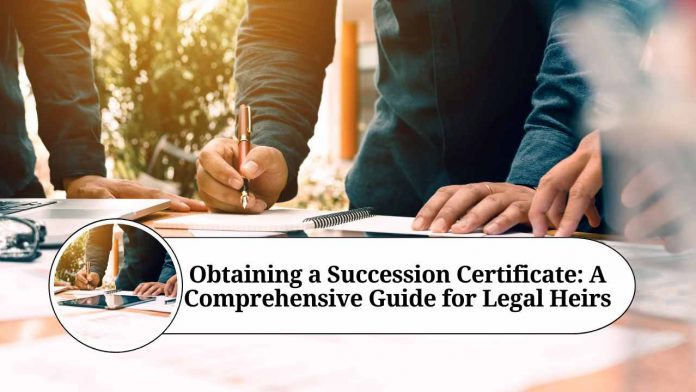Introduction:
Losing a loved one is undoubtedly a difficult and emotionally overwhelming experience. In addition to the emotional challenges, it often brings along legal and financial complexities. One such crucial aspect is acquiring a succession certificate. A succession certificate is a legal document that grants the right to the legal heirs to claim the assets and liabilities of the deceased. In this blog, we will provide you with a step-by-step guide on how to obtain a succession certificate, ensuring a smoother transition during this challenging time.
Step 1: Understand the Purpose and Importance of a Succession Certificate
Before delving into the process, it’s essential to understand why a succession certificate is necessary. A succession certificate serves as proof of the right of a legal heir to receive the assets of the deceased. It allows the legal heirs to transfer, sell, or distribute the assets, settle debts, and manage the estate. It also serves as protection against any potential legal disputes in the future.
Step 2: Identify the Relevant Laws and Jurisdiction
Laws regarding succession certificates may vary depending on the country and its legal system. It is crucial to identify the laws and regulations specific to your jurisdiction. Consult an attorney or legal expert to gain a thorough understanding of the legal framework and procedural requirements in your region.
Step 3: Gather Essential Documents
To apply for a succession certificate, you need to collect the following documents:
- Death certificate of the deceased: Obtain the official death certificate from the concerned authority, typically the municipal corporation or local registrar of births and deaths.
- Identity proof of the deceased: Gather documents that establish the identity of the deceased, such as their passport, PAN card, voter ID, or Aadhaar card.
- Proof of residence: Collect documents that verify the last residential address of the deceased, such as utility bills, rental agreements, or property ownership documents.
- Relationship proof: Gather documents that establish your relationship with the deceased, such as birth certificates, marriage certificates, or family tree records.
- List of assets and liabilities: Create a comprehensive inventory of the deceased’s assets and liabilities, including bank accounts, investments, properties, loans, and any other relevant financial information.
Step 4: Prepare the Application
Once you have gathered the necessary documents, it’s time to prepare the application for the succession certificate. The application must include the following information:
- Personal details: Provide personal information about the legal heirs, such as their names, addresses, and relationship with the deceased.
- Details of the deceased: Include the name, date of death, last known address, and any other pertinent details of the deceased.
- Inventory of assets and liabilities: Prepare a detailed list of the assets and liabilities of the deceased, including their approximate value.
- Court fees: Check the prescribed court fees for filing the application and ensure you have the required amount ready.
Step 5: File the Application
Submit the application along with the required documents to the appropriate court. The court may vary based on your jurisdiction, so consult with your attorney or legal advisor for specific guidance. Pay the applicable court fees and obtain a receipt as proof of submission.
Step 6: Court Proceedings and Verification
After filing the application, the court will review the documents and conduct necessary proceedings. This may include publishing notices in local newspapers to invite any objections from interested parties. The court will then verify the authenticity of the documents and the claim of the legal heirs.
Step 7: Grant of Succession Certificate
If the court is satisfied with the application and finds no valid objections, it will issue the succession certificate. The certificate will typically mention the names of the legal heirs entitled to the assets and liabilities of the deceased.
Conclusion:
Acquiring a succession certificate is a crucial step in managing the legal and financial affairs of a deceased loved one. While the process may seem daunting, following the steps outlined in this guide can help simplify the procedure. Remember to consult with legal experts or attorneys who specialize in succession matters to ensure compliance with the laws of your jurisdiction. Obtaining a succession certificate will provide you with the necessary legal authorization to handle the estate, helping you navigate the challenging terrain of asset distribution and debt settlement during this difficult time.
Read more useful content:
- Occupancy Certificate Online
- ETA Certificate
- Model Approval Certificates
- Legal Metrology Certificate
Frequently Asked Questions (FAQs)
What is a succession certificate?
A succession certificate is a legal document granted by a court that establishes the right of the legal heirs to receive the assets and liabilities of a deceased person.
Who can apply for a succession certificate?
The legal heirs of the deceased, such as spouse, children, parents, or other family members, can apply for a succession certificate. The specific eligibility criteria may vary depending on the jurisdiction.
Why is a succession certificate important?
A succession certificate is important as it provides the legal heirs with the authority to manage and distribute the assets and liabilities of the deceased. It helps prevent disputes and ensures a smooth transfer of property and settlement of debts.
How long does it take to obtain a succession certificate?
The time taken to obtain a succession certificate varies depending on factors such as the complexity of the case, court procedures, and the workload of the court. It can typically take several months to a year or more.
What documents are required to apply for a succession certificate?
The documents required for a succession certificate application include the death certificate of the deceased, identity proof of the deceased, proof of residence, relationship proof with the deceased, and a comprehensive list of assets and liabilities.
Can a succession certificate be obtained without going to court?
No, a succession certificate can only be obtained through a court process. It requires filing an application in the appropriate court and following the legal procedures established by the jurisdiction.
Can multiple succession certificates be issued?
No, generally, only one succession certificate is issued for the estate of a deceased person. This certificate includes the names of all the legal heirs entitled to the assets and liabilities.
Can a succession certificate be challenged?
Yes, in certain circumstances, a succession certificate can be challenged in court. Interested parties may file objections if they believe that the certificate has been obtained fraudulently or if they have a legitimate claim to the estate.
Is a succession certificate valid in all jurisdictions?
A succession certificate is valid within the jurisdiction where it is issued. If the deceased had assets or properties in multiple jurisdictions, it may be necessary to obtain separate certificates for each jurisdiction.
Can a succession certificate be revoked or canceled?
In some cases, a succession certificate can be canceled or revoked if it is proven that it was obtained through fraud or misrepresentation. The interested parties can approach the court to challenge the certificate and provide evidence to support their claim.




















